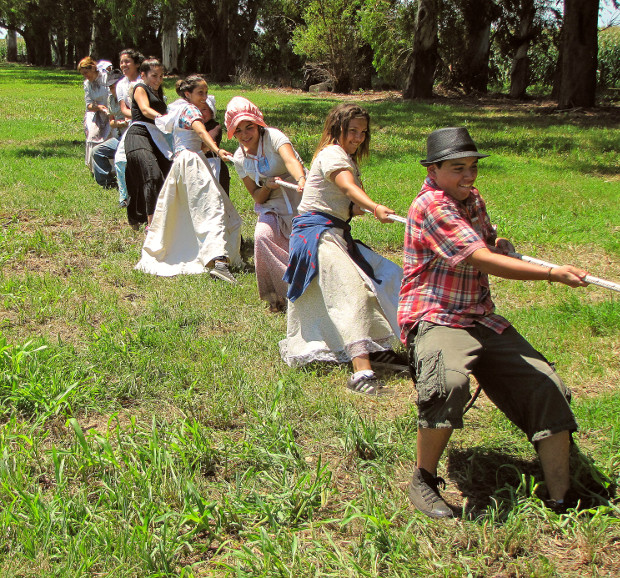Missionaries Organize a Handcart Trek across the Pampas of Argentina
Contributed By Jason Swensen, Church News staff writer

A group of young women from the Adrogue Argentina Stake pull a handcart across muddy trails during a trek in central Argentina.
Article Highlights
- Missionaries and a team of volunteers made handcarts and set about developing a trek system across Argentine farms that included water features and uneven terrain.
- They enlisted a team of bilingual members in Argentina and the United States to translate pioneer stories from English to Spanish.
- The Argentina handcart treks have become popular for stakes and districts across the country.
“We felt strongly that a handcart trek on the farm would truly be a blessing in the lives of the Argentine youth and their leaders.” —Elder Blaine Flinders, a farm missionary called to Argentina
Related Links
The Mormon pioneers’ westward trek to the Salt Lake Valley was fueled by equal measures of faith and gritty resourcefulness. The pioneers utilized wits and cooperation even as they humbly invoked the Lord’s guiding hand.
That concept of “prayerful self-reliance” defined the pioneers. It’s a guiding principle that remains essential for Latter-day Saints today. Each year, thousands of LDS youth leave behind contemporary comforts and, for a few days, embark on handcart treks. The treks allow young people to deepen their understanding of the Mormon pioneers even as they claim the Church’s pioneer legacy as their own.
Five years ago, Utah residents Blaine and Ann Flinders accepted a call as farm missionaries to Argentina. One of their first assignments was to manage the Church-owned, 5,000-acre Kilgruman Farm near the city of Cordoba. The vast and isolated property included recreational amenities such as soccer fields and a swimming pool and was a popular destination for Church groups and families. The farm also owned a few aging handcarts that were occasionally used by visiting Mutual groups for two- or three-hour “pioneer walks.”
The handcarts were at the farm thanks to the foresight of earlier senior missionaries at the farm.
“But the walks were nothing like a real handcart trek,” said Elder Flinders. “A handcart trek … is an encounter with reality.”
The short walks did not allow participants to step from their 21st-century lives for several days and work and pray together as “families” while learning the life-altering, historical accounts of Mormon pioneers.
“We felt strongly that a handcart trek on the farm would truly be a blessing in the lives of the Argentine youth and their leaders,” he said.
Organizing a three-day handcart trek across the vast Kilgruman Farm demanded a pioneer-like effort. First were the handcarts the participants would push and pull. Many of the existing handcarts were showing their age. So the Flinderses began scouring salvage yards and trade shops across central Argentina in search of iron wheels and other materials that could be used to improve and fabricate handcarts. Then a trailer was also located to haul several portable toilets across each trek route.
The Flinderses and a team of volunteers also set about developing a trek system across the farms that included water features and uneven terrain. They felled trees and cleared acres of brush to make a path for the handcarts.
But a handcart trek is far more than a wilderness adventure. It’s an outdoor classroom where gospel lessons are taught along dusty trails and under starry nights. The Flinderses desired for the Argentine participants to truly come to know the men, women, and children who were part of the Willie and Martin handcart companies. Unfortunately, few of their faith-building accounts were available in Spanish. So they enlisted a team of bilingual members in Argentina and the United States to translate the pioneer stories from English to Spanish.
A few local stake leaders had to be sold, initially, on the idea of a handcart trek. Some felt such a trek was suited for North Americans or LDS youth who had direct family ties to the Mormon pioneers.
“But we all share the same pioneer legacy and heritage in the Church,” said Elder Flinders.
The Argentina handcart treks have become popular for stakes and districts across the country. In the past five years, thousands of Argentine Latter-day Saints, along with many of their friends, have taken part in Kilgruman Farm handcart treks. A second trek system has also been developed, allowing two stakes to use the farm at the same time.
Devotionals enrich each day of trek. Participants learn about the Mormon pioneers—and becoming modern-day pioneers. Quiet time is spent with scriptures, and each young man and young woman is presented with a personal letter written by their parents.
The Kilgruman treks conclude with a makeshift viewing of the pioneer-themed film 17 Miracles and a testimony meeting.
“The youth have experiences here that they will never forget,” Elder Flinders said.

Youth from Rosario, Argentina, unfurl a local flag during a Church-sponsored handcart trek in central Argentina. Courtesy of Elder Blaine Flinders.

A trio of young men pushes a handcart during a recent pioneer trek in central Argentina. Courtesy of Elder Blaine Flinders.

Youth and advisers from the San Nicolas Argentina Stake gather for an outdoor devotional during a three-day handcart trek in central Argentina. Courtesy of Elder Blaine Flinders.

Young men and young women strain together during a game of tug-of-war during a pioneer handcart trek in central Argentina. Courtesy of Elder Blaine Flinders.

Youth and advisers from the Congreso Argentina Stake form a handcart procession during a pioneer trek in central Argentina. Courtesy of Elder Blaine Flinders.

Youth from the Congreso Argentina Stake pull a handcart during a recent pioneer trek. Courtesy of Elder Blaine Flinders.
